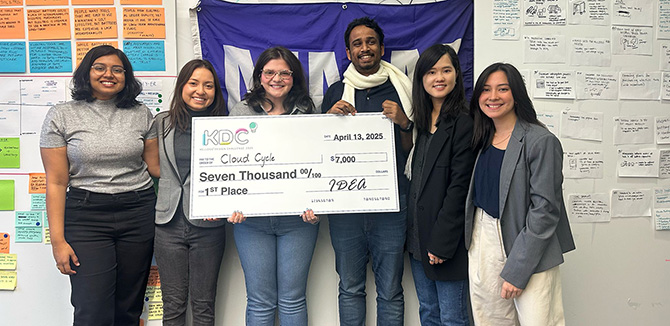Human-Centered KDC Victory
A team of six MMM students won the Kellogg Design Challenge (KDC) by applying lessons learned from their time in Northwestern’s MBA + MS Design Innovation (MMM) program.

Gaurav Gandhi (MMM '26) knows that he learns better when he can work on a real project, rather than just reading about theory and taking exams.
When he applied to Northwestern’s MBA + MS Design Innovation (MMM) program — a dual-degree program between Northwestern Engineering and the Kellogg School of Management — he wrote that he wanted to participate in the Kellogg Design Challenge (KDC) as a way to apply learned lessons to a real business challenge.
In April, Gandhi did just that.
Not only did he compete, but he, Helena Augenstein (MMM '26), Chaitali Dhande (MMM '26), Rachel Dodell (MMM '26), Angel Gayatin (MMM '26), and Shelina Hsieh (MMM '26) won the KDC, the largest business design case competition across MBA programs in the world.
This year’s challenge was sponsored by Honda and asked teams to envision sustainable, human-centered innovations in mobility that could launch within one to three years. Gandhi credited his team's MMM experience — and specifically lessons learned in the program's Research-Design-Build (RDB) course— with being key to their KDC success.
"You want to go somewhere where there is white space, that's the biggest area of opportunity," Gandhi said. "That's where we leaned for our solution."
The students took a human-centered approach to help Honda transition its power tools division toward a more sustainable future. Their focus was electrifying landscaping and outdoor maintenance equipment to create a greener, quieter future for yards and cities.
The team’s solution focused on addressing the concerns of small business owners in the landscaping industry. The students proposed a series of innovations, including improved battery gauges and a specialized truck designed for landscapers using electric tools.
“The challenging part was that it had to tick off three different areas,” Augenstein said. “It obviously needed to be human-centered, which feeds into all the desirability characteristics that we learned about through MMM, but, two, it also needed to be profitable for Honda. Then, three, it also had to be sustainable, and the Venn diagram of those three things is somewhat limited.”
Limited, but not impossible.
As the students considered areas to focus their project, they landed on Honda's power tools segment.
"They have a huge presence in lawnmowers and gas powered equipment, and the whole industry is moving toward more sustainable, electric-powered offerings," Gandhi said. "That's how our initial prompt started."
Throughout the project, the students kept users top of mind.
"We started from a human-centered lens and went to Home Depot to Lowe's to understand what the market looks like on the ground rather than just doing secondary research, which was something that was ingrained in us in the RDB class," Gayatin said.
The KDC is hosted by the Kellogg Innovation and Design Association (IDEA) club and draws participants from various MBA programs across the country.
KDC offers students a unique opportunity to apply their design thinking skills to real-world business challenges, bridging the gap between theoretical knowledge and practical application. The competition’s scale and prestige make it a significant platform for aspiring business leaders to showcase their innovative problem-solving abilities and gain exposure to industry-relevant issues.
“We relied a lot on the process that we did in RDB,” Augenstein said. “We made the whole presentation user-focused. We selected a user profile, we did solutions for them, and we did journey mapping of the solution for them, which I think was a standout for us.”
As Augenstein and her teammates prepare for summer internships, they recognize the value of their KDC experience. Just as importantly, they see how the opportunity will prepare them for success this summer and throughout their careers.
“The design-thinking ideology is just ingrained in us," Augenstein said. "We know that these are the things you need to do. This is how you need to approach a problem, and this is how you need to ideate to go into problem solving.”
